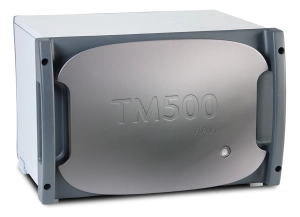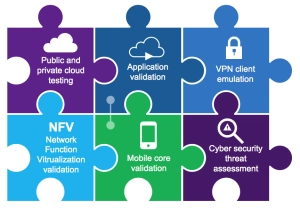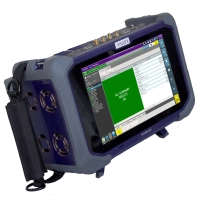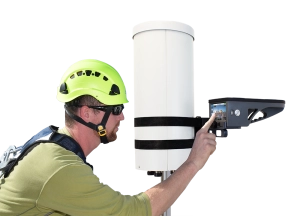What is 5G Technology?
5G technology brings tremendous benefits and advantages along with significant challenges for network developers, operators, and service providers.
5G technology has taken digital communication to the next level. The fifth generation of cellular technology has exponentially increased coverage, speed, and capacity. The possibilities for new and existing industries depending on millisecond latency and seamless reliability are almost limitless, although the broad scope of technology and infrastructure changes also bring challenges. Vital elements of breakthrough 5G technology include:
- Millimeter wave transmission between 24 to 100 GHz which introduces more available spectrum to support faster 5G data transfer.
- Massive MIMO (multiple input, multiple output) antenna arrays featuring dozens of small, individually tunable antennas in a compact physical space.
- Beamforming technology enabling 5G signals to be transmitted to end users more directly.
- Network slicing, which is the intelligent partitioning of resources based on the service being delivered. Multiple virtual networks run over the same physical infrastructure simultaneously.
The enhanced speed of 5G technology might seem like going from covered wagon to transcontinental airliner in one swift step, and for good reason.
Real-world 5G speeds are around ten times faster than 4G, with trial speeds of up to 70 Gbps reported. Actual 5G speeds increase as more networks deploy 5G standalone architecture and utilize millimeter wave frequencies.
5G technology also decreases latency significantly. This is an important factor for new applications like self-driving cars and “virtual” robotic surgeries that rely on instantaneous communication. Latency in the 1 millisecond (ms) range can be achieved with 5G, whereas latency of around 20 ms was typical for 4G.
The trade-off for speed at mmWave frequencies is the limited range. 5G service range in the mmWave is limited to about 600 meters. Since a considerable number of MIMO-enabled antenna arrays would be required for mmWave-only 5G deployment, underutilized low and mid-band frequencies between 300 MHz and 3 GHz and C-band frequencies between 3.7 and 3.98 GHz have also been repurposed for 5G.
- The inability of millimeter wave signals to penetrate obstructions further limits the range potential and becomes a key network design consideration.
- 5G network disaggregation allows for more flexible architectures in 5G, with the base station broken into new logical elements.
- Flexible deployment options allow the available network real estate to be used more efficiently.
- Operators utilize small cell technology and other creative alternatives to the traditional cell tower effectively to make standalone 5G networks viable.
The need for 5G technology was driven by a persistent demand for enhanced speed, better security, and new applications for both consumers and businesses. However, many users remain unaware of the impact of 5G is having on their everyday lives.
- Exponentially faster streaming of videos and other content is the most immediately evident benefit.
- Direct 5G internet connection speeds for home WiFi systems are on par with most fiber optic networks.
- Banking, automotive, and agriculture are among the industries experiencing the impact of the Internet of Things (IoT) directly.
- ATMs, automobiles, production tools, and irrigation equipment are becoming part of the vast network of “smart” products.
- The healthcare industry is also experiencing an unprecedented transition, with millions of wearable devices streaming data to doctors and clinicians and the improved transmission of large data files.
The Impact for Service Providers
5G service providers continue to build additional infrastructure to support the growing 5G demand, as the number and diversity of available 5G cell phones and other mobile devices continue to expand.
Massive MIMO deployment on existing towers has been a convenient bridge between LTE and 5G for many service providers. The shorter range of 5G in mmWave and increased antenna quantities have driven competition and cost-cutting innovations among providers during deployment, while the varying applications of 5G lead to more diverse service menu options.
- Open RAN brings greater interoperability and standardization of RAN elements while providing the intelligence and flexibility needed to improve efficiency.
- The IoT is changing how service providers interact with customers, with high-density, low-bandwidth applications shifting the focus to overall quality of experience (QoE).
- Private 5G applications such as factory automation, healthcare, and financial services count reliability as a driving value factor for customers.
- Mission critical communications for emergency response, public safety, and other essential applications are enhanced by the real-time data analysis and proximity-based services brought by reliable 5G technology.
Some negative consequences at least partially offset the benefits of most major advancements in technology. The same holds for 5G as operators and service providers strive to improve and monetize 5G technology in the face of increased technical complexity.
5G Advantages
The speed and latency improvements that 5G brings are an obvious and significant advantage over 4G and the standards that preceded it. The up-swing in device support made possible by the directional signal delivery of MIMO antenna arrays is another essential benefit. Additional advantages of 5G technology include:
- Network function virtualization (NFV) reduces the volume of hardware and contributes to energy efficiency.
- Improved network intelligence supports mobility and makes 5G cell to cell handoffs smoother.
- Network slicing technology provides a greater diversity of services over the same physical infrastructure.
- Cloud-native core architecture is used to deploy and scale new applications and services more quickly.
- Widespread IoT device deployment and management capabilities are supported by 5G technology.
- Energy Savings are produced by artificial intelligence (AI) and machine learning (ML) elements of the RAN that power off or reconfigure cells in real time based on subscriber location intelligence.
5G Technology Drawbacks and Dangers
Much like the inherent advantages of 5G, many drawbacks also stem from the shift to higher frequencies and the behavior of radio signals in the millimeter wave. A shorter range and increased susceptibility to obstructions are the most apparent disadvantages in this category. High frequencies are also more susceptible to humidity and rain, so the already-limited range is further challenged by weather conditions.
Additional drawbacks and dangers associated with 5G technology include:
- Aesthetic and environmental issues related to high cell and antenna density.
- Higher maintenance, repair, and troubleshooting costs that are proportional to the high volume of cell sites, antennas, and fiber.
- Overall, 5G energy consumption is 4 to 5 times higher than 4G due to increased density and traffic.
- The increased volume of IoT attack surfaces and a multi-vendor 5G RAN ecosystem introduce new security vulnerabilities.
Along with naturally occurring sources of RF interference like static electricity, and man-made sources like radiation from network antennas, 5G networks must also contend with new interference sources caused by increased cell density and new 5G technology.
- Passive intermodulation (PIM) causes signal interference when multi-frequency 5G signals contact corroded cell tower hardware.
- Overlaps in cell coverage or incompatible time division duplex (TDD) frame structures between adjacent cells can lead to co-channel or inter-cell interference issues.
The planning, deployment, and operation of flexible, virtualized 5G network architecture challenges operators in many new ways. 5G technology requires a new category of test solutions and expertise.
5G Technology from VIAVI
The impact of 5G technology on operators, service providers, and end users is as revolutionary as the technology itself. Test solutions that keep pace with 5G advancements while remaining flexible to the changes in standards and deployment strategies are essential. Innovative VIAVI 5G testing tools have built a bridge between previous generations and the new 5G paradigm.
Lab Validation
Rigorous testing through the design and development phase is vital to the success of 5G deployments. The earlier you test, the earlier you find problems. Testing may be complex, but it does not need to be difficult.
The VIAVI TM500 is the industry standard for base station development and testing via RF. This scalable test system validates 5G network performance as experienced by end users across multiple cells and access technologies. The TM500 is meeting 5G network test challenges by delivering realistic voice, data, and mobility models along with 5G core emulation as part of the industry’s most comprehensive lab validation portfolio.


TeraVM is a virtualized application emulation and security performance test solution that ensures 5G technology is highly optimized with minimal risk upon delivery. TeraVM is leading the way with the industry’s first NFV test solution and first RAN Intelligent Controller (RIC) test suite to emulate all Open RAN elements accurately.
The TeraVM Core Emulator aligns to the latest 3GPP standards to simplify the development of 5G RAN networks. When used in conjunction with the TM500, TeraVM can perform full 5G wrap-around testing in both standalone and non-standalone modes.
Field Verification
Test solutions for installation, commissioning, and troubleshooting of 5G cell sites have risen to the challenges of complex 5G technology. VIAVI field verification solutions include advanced antenna alignment, X-haul validation, PIM detection, and spectrum analysis tools.

The VIAVI OneAdvisor 800 is an all-in-one cell site installation and maintenance solution designed to verify 5G radio transmission according to 3GPP standards. Real-time spectrum analysis (RTSA) and persistence power measurements are used to characterize or troubleshoot 5G RAN performance and locate multiple sources of signal interference. The OneAdvisor 800 also simplifies fiber end face inspection and integrity testing.
Precise 5G antenna alignment reduces wasteful RF overlap and coverage gaps. The 3Z RF Vision is a forward-looking antenna alignment tool that synchronizes RF design with real-world antenna alignment to maximize performance and efficiency. A user-friendly line-of-sight camera and augmented reality support the intuitive, fast, and accurate alignment process.

Network Assurance, Intelligence, Optimization
5G monitoring, maintenance, and optimization solutions ensure the long-term integrity of 5G technology and safeguard the customer experience. Network visibility is enhanced by advanced geolocation capabilities and location intelligence that feed into unprecedented 5G service assurance and analytics.
NITRO Location Intelligence continuously captures, locates, and analyzes data from all 5G subscribers’ events with building-level accuracy to reveal how the network is performing anytime and anywhere. Rich geolocated insights provide mobile service providers with complete visibility into network performance and quality of experience (QoE), while supporting a broad set of use cases that improve efficiency and lower costs.
VIAVI NITRO AIOPS solutions empower service providers to evolve their legacy Network Operations Center (NOC) to Dark NOC and get end-to-end network visibility across Cloud, Mobility, IT/MEC and IoT platforms. The suite covers Cloud Native Inventory, Service Assurance, AI and ML driven Assurance, Customer and Service Analytics, and Network Automation Solutions. Key features include:
- Real-time routing visibility
- Capacity prediction and forecasting
- Cross-domain operations support
- Automated remediation